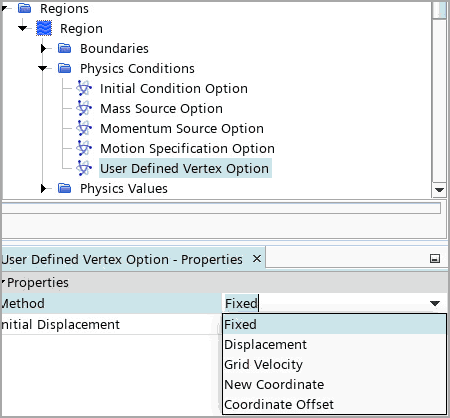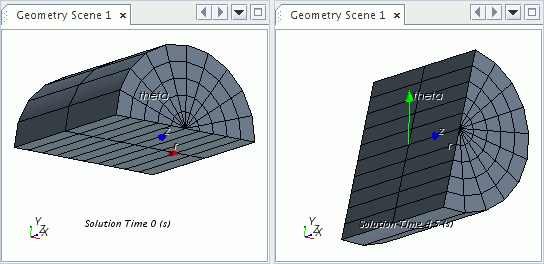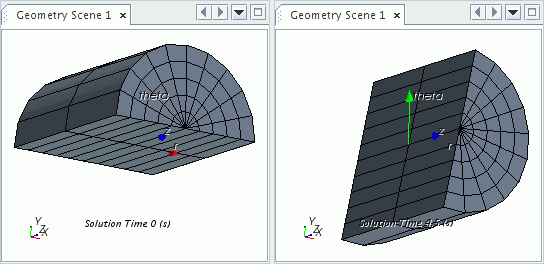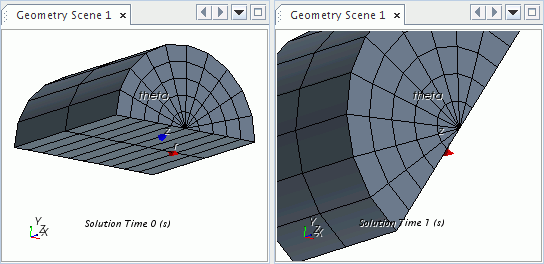Setting the Quantity for User-Defined Motion
User-defined motion can be specified in terms of displacement, grid velocity, new coordinates or coordinate offset. The choice between these quantities is made using the Method property of the User-Defined Vertex Option node.

| Method | Specifies the method by which the mesh motion is defined. | |
| Fixed | No vertex motion. Use this method when solving for initial flow fields, particularly in cases for fluid-structure interaction. | |
| Displacement | Move vertices by a specified displacement. Adds the Linear Displacement node to the Physics Values folder of the region. | |
| Grid Velocity | Calculate vertex movement within a time step using a grid velocity. Adds the Grid Velocity node to the Physics Values folder of the region. | |
| New Coordinate | Specify new coordinates at each time step. Adds the New Coordinate node to the Physics Values folder of the region. | |
| Coordinate Offset | Specify an offset by which vertices move at each time step. Adds the Coordinate Offset node to the Physics Values folder of the region. | |
| Initial Displacement | Specifies whether to modify the mesh generation position by adding a displacement. | |
| Activated | The vertices of the mesh are moved by the initial displacement. Adds the Initial Displacement node to the
Physics Values folder of the region.
For more information, see What Is the Initial Displacement?. |
|
| Deactivated | The vertices of the mesh remain in the mesh generation position. This position is used as the initial position. | |
What Is the Linear Displacement?
Use this method to set the linear displacement of vertices in the parent region for which a user-defined vertex motion is active. This method is valid only with Cartesian coordinate systems. Do not use this method in cylindrical or spherical coordinates. For vertex motion in these coordinate systems, use the New Coordinate or Coordinate Offset methods.
The Linear Displacement node acts as a vector profile and has a single additional property for the type of displacement.
Properties
| Total Displacement | Use this property to specify whether the displacement is taken as incremental (applying the same displacement at each time step), or whether it is taken as a total displacement relative to the initial mesh at time zero. Use this latter option when you supply displacements as an absolute value. | |
| Activated | The specified displacement is treated as a total value relative to the initial position at time zero. | |
| Deactivated | The specified displacement is applied to the vertices based on their position at the start of each time step. | |
| Coordinate System | Coordinate system in which the displacements are defined. | |
| Method | The method that is used to define the value for the Linear Displacement. | |
| Dimensions | The dimensionality of the property that is expressed in terms of the basic dimensions, such as length, time (read-only). | |
What Is the Grid Velocity?
Use this node to set the grid velocity that is applied to vertices in the parent region when a user-defined vertex motion is active. This node acts as a vector profile.
This method is valid only with Cartesian coordinate systems. Do not use this method in cylindrical or spherical coordinates. For vertex motion in these coordinate systems, use the New Coordinate or Coordinate Offset methods.
The coordinate system of the field function must be identical to the coordinate system that is used in the field function definition.
What Is the New Coordinate?
Use this node to specify the new coordinates for the vertices at each time step. The coordinates can be specified in the Cartesian, Cylindrical, or Spherical coordinates system.
Consider a half-section of a cylinder for rotation with a constant angular velocity about its axis:

You can use a field function to rotate this cylindrical section:
- Set the Coordinate System to the cylindrical coordinate system of the mesh for rotation, for example:
- Create a field function with a
Definition of the form:
[ $$Position(@CoordinateSystem("Cylindrical 1"))[0], $$Position(@CoordinateSystem("Cylindrical 1"))[1]+0.1, $$Position[2] ] - Set the New CoordinateMethod to Field Function and select the field function that is defined in the previous step.
The coordinate system of the field function must be identical to the coordinate system that is used in the field function definition.
Properties
| Coordinate System | Coordinate system in which the origin is defined. | |
|
Method |
The method that is used to define the value for the New Coordinate. | |
| Field Function | Defines the value using a field function (typically user defined). | |
| User Code | Defines the value using a user subroutine. | |
|
Vector Function |
Activates an object selector dialog from which you can choose a field function. This property is only available when Method is set to Field Function. |
|
|
Function |
Provides a drop-down list from which you can choose a user function. This property is only available when Method is set to User Code. |
|
What Is the Coordinate Offset?
Use this node to specify the change in coordinates of the vertices at each time step. The change in coordinates can be specified in the Cartesian, Cylindrical, or Spherical coordinates system.
Consider the following section of a cylinder for rotation with a constant angular velocity about its axis:

- Set the Coordinate System to the cylindrical coordinate system of the mesh for rotation, for example:
- Use the Constant method with a value of [0.0, 0.1, 0.0] for example.
If the mesh must grow in the radial direction as it is rotated, you cannot use the Constant method. Each radial vertex value increases at a different rate, depending on its radial position. Instead, use the Field Function method with a field function such as:
[ $$Position( @CoordinateSystem("Cylindrical 1"))[0] * 0.05, 0.1, 0.0 ]
The coordinate system of the field function must be identical to the coordinate system that is used in the field function definition.
Properties
| Coordinate System | Coordinate system in which the origin is defined. | |
| Method | The method that is used to define the value for the Coordinate Offset. | |
| Constant | Specifies the value as a constant array. | |
| Field Function | Defines the value using a field function (typically user defined). | |
| User Code | Defines the value using a user subroutine. | |
|
Value |
Specifies the x, y, and z values. These values are separated by commas in a text entry. You can also enter an expression, such as 10 * sin(3.14 * $Time), directly. The property customizer opens a dialog which contains separate fields for these values. This property is only available when Method is set to Constant. |
|
|
Vector Function |
Activates an object selector dialog from which you can choose a field function. This property is only available when Method is set to Field Function. |
|
|
Function |
Provides a drop-down list from which you can choose a user function. This property is only available when Method is set to User Code. |
|
What Is the Initial Displacement?
Use this node to adjust the mesh from the mesh generation position to the initial mesh position for the simulation. You specify an initial displacement by which the vertices are moved from the mesh generation position to the initial mesh position of the simulation. The initial displacement is applied only once at the start of the simulation to obtain the initial position for the simulation. The initial position is used to initialize the flow field. Note that selecting Solution > resets the mesh back to the mesh generation position.
Properties
| Coordinate System | Coordinate system in which the initial displacement vector is defined. | |
| Method | The method that is used to define the value for the Initial Displacement. | |
| Dimensions | The dimensionality of the property that is expressed in terms of the basic dimensions, such as length (read-only). | |
|
Value |
Specifies the x, y, and z values. These values are separated by commas in a text entry. You can also enter an expression, such as 10 * sin(3.14 * $Time), directly. The property customizer opens a dialog which contains separate fields for these values. This property is only available when Method is set to Constant. |
|
|
Vector Function |
Activates an object selector dialog from which you can choose a field function. This property is only available when Method is set to Field Function. |
|
|
Function |
Provides a drop-down list from which you can choose a user function. This property is only available when Method is set to User Code. |
|